Understanding the Rutting Season of Deer Behavior
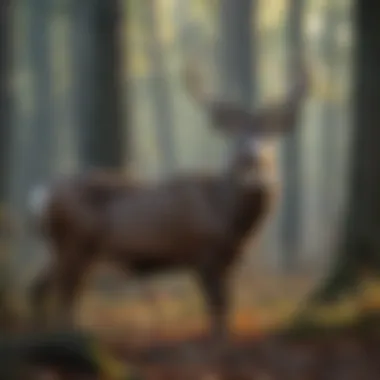
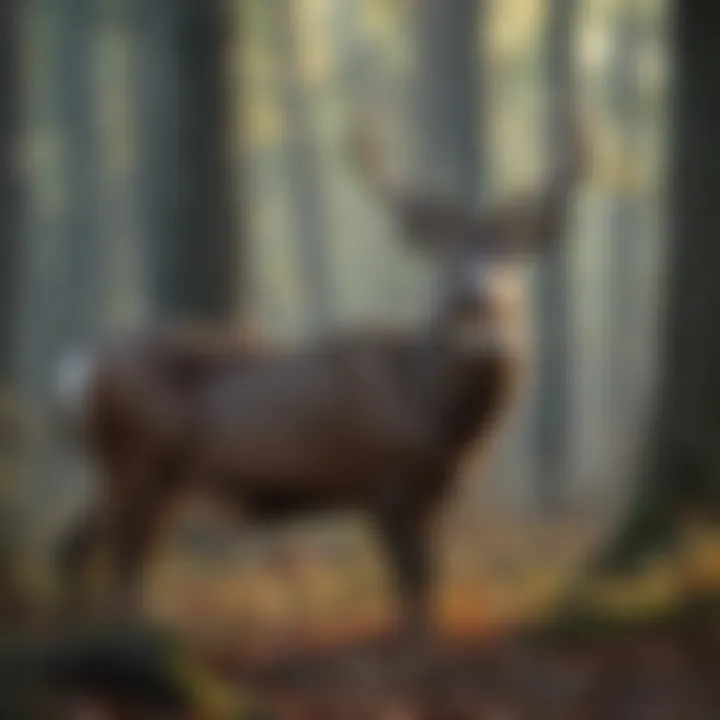
Overview of the Topic
Foreword to the Key Natural Resource or Environmental Issue Being Discussed
The rutting season for deer, often viewed as nature's grand spectacle, plays a pivotal role in the life cycle of these mammals. The period, marked by heightened aggression and courting behaviors, is crucial for reproduction and population sustainability. During this time, deer exhibit a dramatic shift in behavior; males engage in fierce battles for mating rights while females, often more discreet, choose their partners with discernment. Understanding this season sheds light on broader ecological dynamics and natural resource management strategies, as deer populations directly influence their ecosystem through their feeding habits and movement patterns.
Background Information on the Significance of the Topic
Rutting season typically occurs in the fall, peaking in November for many species in North America. This timing aligns with the availability of food resources and environmental conditions favorable for fawning in spring. Moreover, the rut impacts myriad species in the food web, from predators that rely on deer for sustenance to plants that deer may overbrowse during these intense periods of activity. Recognizing the rhythms of deer rutting can inform not just wildlife observation, but also effective management practices aimed at maintaining healthy populations and preserving habitat integrity. In this light, it’s essential to look closely at what exactly influences this season and how it unfolds in various environments.
Current Status and Challenges
Examination of the Current State of the Natural Resource or Environmental Concern
Today, many deer populations are grappling with the consequences of habitat loss, urban development, and climate change. Areas once rich in natural foliage now see diminished food sources, affecting reproductive rates and overall health of the deer populace. In addition, increased interaction with humans leads to greater challenges, as deer find themselves navigating urban landscapes and encountering vehicles, which can result in injury or death.
Identification of Challenges and Threats Facing the Topic
There are several hurdles on the path to maintaining healthy deer populations:
- Habitat Fragmentation: Urban sprawl and agricultural development cut into deer habitats, disrupt migration routes, and limit the accessibility of crucial resources.
- Climate Variability: Changes in temperature and weather patterns alter food availability and disrupt timing of the rut.
- Disease Transmission: Outbreaks of chronic wasting disease (CWD) and other ailments represent threats that can decimate local herds.
- Human Interaction: Encounters with humans can lead to behaviors that jeopardize not only the deer but also people, resulting in accidents and a rise in hunting regulations.
Sustainable Solutions
Exploration of Sustainable Practices and Solutions to Address the Issues Highlighted
Strategies to ensure the health of deer populations involve a multifaceted approach:
- Habitat Restoration: Initiatives aimed at preserving and restoring natural habitats can promote deer populations’ resilience.
- Controlled Hunting: Implementing regulated hunting seasons can help balance deer numbers with available resources, preventing overpopulation and related diseases.
- Public Awareness: Educating communities about deer behaviors, particularly during rut, can minimize dangerous encounters and foster coexistence.
Showcase of Successful Case Studies or Examples of Effective Resource Management
One notable example comes from the Sierra Nevada Region, where coordinated efforts between state agencies and local wildlife groups have yielded positive results. By setting up conservation easements and creating wildlife corridors, many deer have been able to navigate seasonal migrations safely, even as urban areas expand. Similarly, educational programs have empowered residents to coexist more harmoniously with these animals, leading to fewer accidents and healthier populations.
Impact and Importance
Analysis of the Impact of the Topic on Ecosystems, Communities, and Future Generations
The behavior of deer during rutting season reverberates across the ecosystem. Their grazing patterns can shape vegetation communities, influencing plant diversity and growth. Furthermore, a robust deer population supports predators like wolves and coyotes, which are vital for a balanced ecosystem. A healthy deer population isn't just beneficial for biodiversity, but also for those who observe and appreciate wildlife.
Emphasis on the Importance of Conservation Efforts and Sustainable Resource Use
Sustainable management practices ultimately determine the fate of deer and their habitat. By fostering an understanding of the rutting season, stakeholders from conservationists to local communities can help steer policies towards a path that respects both wildlife needs and human development. This collaborative effort will ensure that the beauty and ecological significance of the rutting season remain for generations to come.
It's imperative that we recognize the implications of changes in deer behavior and populations, for our own well-being is interwoven with the health of their ecosystems.
Intro to Rutting Season
The rutting season, often referred to as the breeding period for deer, is not merely a phase in the life of these animals. It's a pivotal time that influences their behavior, population dynamics, and ecological interactions. Getting a grasp on this season goes beyond mere curiosity; it’s important for conservationists, students, and environmentalists alike, fostering a deeper relationship and understanding of wildlife management.
Defining Rutting Season
Rutting season can be defined as the annual reproductive phase during which male deer, commonly known as bucks, engage in displays of dominance and courtship behaviors to attract females, or does. This period generally occurs in the fall months, but the exact timing varies significantly based on geographical location. During this time, bucks exhibit heightened aggression, often fighting with one another to establish dominance and mating rights. It's fascinating to note that during the rut, the behavior of deer can shift dramatically, moving from solitary to more social interactions as males seek out available females.
The signs of rutting season can sometimes be hard to miss. Bucks will scrape trees and rub their antlers against bark to mark their territory, while their scents become more potent, signaling their readiness to mate. Observing such behaviors is not just interesting but essential for understanding the ecological balance in their habitats.
Importance of Understanding Rutting Season
Understanding the rutting season is crucial for several reasons. Firstly, it provides insight into deer population dynamics. The timing and success of mating directly impact the number of fawns born the following spring, which subsequently affects food resources and habitat use. Moreover, an informed perspective on the rut allows conservationists to create suitable strategies that support both deer populations and their ecosystems. For instance, hunting regulations often rely on a thorough understanding of these seasonal shifts to ensure sustainable practices.
Additionally, knowing when rutting occurs allows wildlife observers and enthusiasts to engage responsibly with nature. Irrespective of whether one aims to photograph, monitor, or simply enjoy watching deer, understanding the rut gives appreciators a chance to witness some of the most compelling behaviors in their natural setting.
In summary, knowing the intricacies of deer rutting season equips us with knowledge that has implications far and wide, from fostering appreciation in wildlife observation to implementing effective conservation practices. The more we understand, the better we can advocate for sustainable interactions with wildlife.
Timing of the Rutting Season Across Regions
Understanding the timing of the rutting season is crucial for wildlife enthusiasts, researchers, and conservationists alike. This period of heightened activity not only affects the behaviour of deer but also influences their reproductive success and overall population dynamics. By comprehending the variances in rutting periods across different regions, one can better appreciate the ecological intricacies that drive these seasonal behaviours. This knowledge further assists in developing conservation strategies that align with these natural cycles, ensuring sustainable populations.
Seasonal Variations by Geographic Location
Rutting season can be as different as night and day depending on where you find yourself. In the northern reaches, such as Canada, the rut typically kicks off later in the year, around late October to early November. Conversely, in the warmer southern climates, like parts of Texas or Florida, it can start as early as September. This variation can be attributed to several factors, including daylight hours and temperature fluctuations. Deer seem to have an internal clock that prepares them for the changes in their environment, which signals when it’s time to seek out mates.
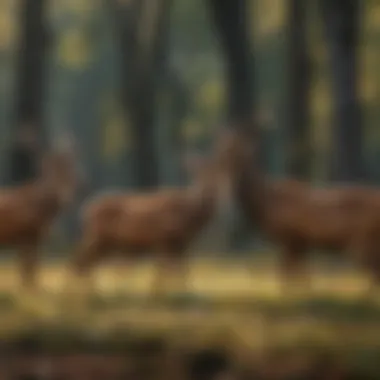
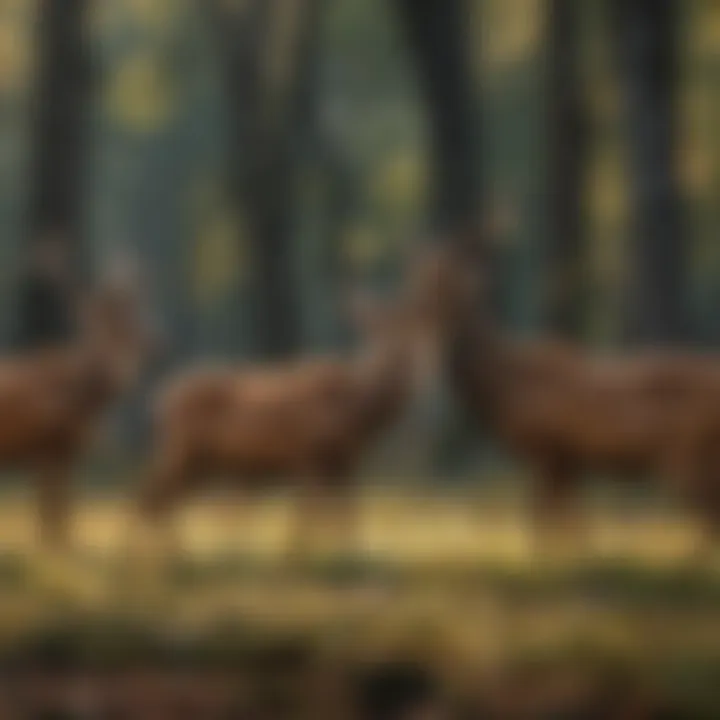
"Understanding the rutting season timings can significantly impact deer management strategies and conservation efforts."
Another interesting aspect is how different species react differently to geographical factors. For example, the white-tailed deer, widespread across North America, often shows varied rut timings from east to west. Areas with higher populations of this species may have a rut that stretches out over several weeks, leading to a staggered peak in fawn births. In contrast, regions with more limited deer populations may experience a more condensed rut, where multiple males vie for the same few females actively.
Influence of Climatic Conditions
Climate plays a pivotal role in influencing the rutting season for deer. As temperatures shift, so do deer behaviours. In regions experiencing unusually warm weather in autumn, the rut may begin later than usual. Deer become increasingly sensitive to temperature changes, which can throw their breeding cycles off-kilter. Cooler temperatures can trigger hormonal changes, prompting males to exhibit rut behaviors sooner.
Seasonal storms, like heavy rain or snowfalls, also exert their influence. If an area has a substantial snowfall early in the season, deer may be compelled to alter their typical mating strategies, possibly leading to earlier mating attempts. As a result, understanding local weather patterns becomes essential to predict and observe deer behaviour effectively.
Moreover, shifts in climate patterns can lead to cascading effects on deer populations. For instance, prolonged drought conditions can reduce food availability, resulting in lower body weights and poorer reproductive performance, which may ultimately disrupt the regular rut timing.
Thus, when one considers both geographic locations and climatic conditions, it becomes evident that the timing of the rutting season is not only a fascinating aspect of deer behaviour but also a complex interplay of ecological factors that require ongoing research and observation.
Behavioral Changes During Rutting Season
Understanding the behavioral changes that occur during the rutting season in deer is crucial for grasping the complexities of their reproductive cycle. This period not only drives the reproductive success of the population but also impacts environmental dynamics and human interaction with deer. The rutting season is a time where male and female deer exhibit distinct changes in behavior, signaling the necessity for conservationists and wildlife observers to tune into these ecological cues.
Changes in Male Deer Behavior
During the rut, male deer display a variety of behaviors that reflect their intense drive to mate. This surge in activity is largely influenced by hormonal fluctuations, notably an increase in testosterone levels. These changes manifest in several key behaviors:
- Aggression Towards Rivals: Male deer often engage in displays of dominance, which can include fighting or posturing. This is a typical sight during the rut, especially among bucks vying for the attention of females. The physical confrontations can impact population dynamics, as stronger males may succeed in securing mates and passing on their genes.
- Marking Territory: Scent marking becomes a critical behavior in male deer during the rut. They often use their antlers to scrape trees and rub against shrubs, leaving behind their scent to signal their presence and strength to potential rivals and prospective mates.
- Increased Vocalizations: During this phase, male deer are more vocal than at any other time of the year. They use grunts and other sounds as both a call to attract females and as a warning to competitors.
These behaviors not only serve the purpose of reproductive success but also reflect the intricate web of interactions among deer populations. The observations of these behaviors offer rich data for wildlife management and can inform strategies to maintain balanced populations.
Female Deer Responses
The responses of female deer during the rutting season are equally fascinating and critical to understanding the dynamics at play. Unlike their male counterparts, females exhibit behaviors that are more about discernment and selective mating:
- Searching for the Best Mates: Female deer tend to be selective and often show preference for stronger males. They may move into areas frequented by high-quality males, keeping an eye on their behaviors and interactions with other deer to evaluate their fitness.
- Increased Social Interactions: During the rut, female deer may become more social, particularly as they compete for the attention of males. This can include grouping together to observe potential mates or even influencing the mating behaviors of males.
- Estrus Cycles: Female deer experience estrus, or heat, during this time. They exhibit changes in body language and behavior to signal their availability, which could include increased scent marking.
The dynamics between male and female deer during the rut are a dance of nature, a complex interplay of instincts that drives the survival of the species.
In summary, observing behavioral changes during the rutting season provides valuable insights into deer ecology that extend beyond mere reproduction. Understanding these shifts enables conservationists, researchers, and wildlife enthusiasts to appreciate the sophistication of deer behavior in the broader context of ecosystem health and sustainability. The implications of these changes resonate with the management of deer populations and the need for informed conservation practices.
Biological Mechanisms Behind the Rut
The rutting season in deer is not merely a time of heightened activity; it's a vital period governed by intricate biological processes. Understanding these mechanisms provides insight into the behaviors observed during the rut and their implications for deer population dynamics. The interplay of hormones and genetic factors drives the physical and behavioral changes in deer, influencing not just their reproductive success but also their survival rates.
Amid the natural rhythm of life, it is nature's way of ensuring the continuation of the species. Many factors come into play, and recognizing their roles leads to a clearer picture of deer behavior during this time.
Hormonal Changes
As the rut approaches, changes in hormone levels initiate a cascade of behavioral modifications in deer. Specifically, testosterone levels surge in male deer, marking a physiological transformation that sharpens their focus on mating. This elevation in testosterone doesn’t just rev up their reproductive drive— it also intensifies aggressive behaviors as males compete for the attention of females.
Meanwhile, female deer, too, experience significant hormonal fluctuations. The rise in progesterone and estrogen aligns their reproductive cycles with the peak of the rut. These hormones signal the peak estrous period, during which females are eager to mate, leading to increased vocalizations and behaviors that attract potential suitors.
- Increased testosterone leads to:
- Fluctuating estrogen enhances:
- Heightened aggression in males
- Urine scent marking that attracts females
- Female receptivity to mating
- Behavioral displays to signal ovulation
Through this hormonal symphony, deer synchronize their reproductive cycles. It’s as if they are on a tightly woven clock. The timing is pivotal; females must be open to mating when males are most driven and eager. This synchronization is key to ensuring that fawns are born at a time when resources are abundant, supporting their survival.
"The biological clock ticks louder as the rut arrives, dictating the rhythm of life in the deer population."
Genetic Influences
Genes play a fundamental role in shaping how individual deer respond to these hormonal signals during the rut. Each deer's genetic makeup influences their adaptability to environmental conditions, which can, in turn, dictate when they enter the rut and how fiercely they compete for mates.
In some cases, certain genetic traits can make a male more attractive to females. For instance, larger antlers, which signal strength and health, often correlate with greater success in attracting mates. As a result, over generations, we see these traits become more pronounced within populations.
Additionally, there are genetic variations influencing maturity rates in both males and females. This variability can lead to different timing in reproductive cycles, which can be beneficial in a natural setting—if not all animals rut at the same time, it reduces competition and increases the likelihood of survival for both the fawns and the mothers.
The interaction of genetic and hormonal factors creates a complex web of influences that define the rutting season. Studying these genetic influences helps conservationists understand and manage deer populations more effective, ensuring sustainable ecosystems.
By grasping the biological mechanisms behind the rut, we gain invaluable insights that are crucial for effective wildlife management and conservation strategies. The insights gleaned shed light on not only the reproductive success of deer but also their overall adaptability and resilience in the face of changing environmental conditions.
Factors Affecting Rutting Timing and Intensity
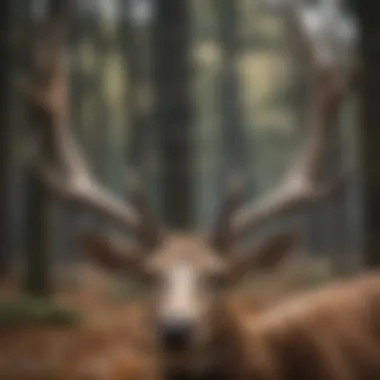
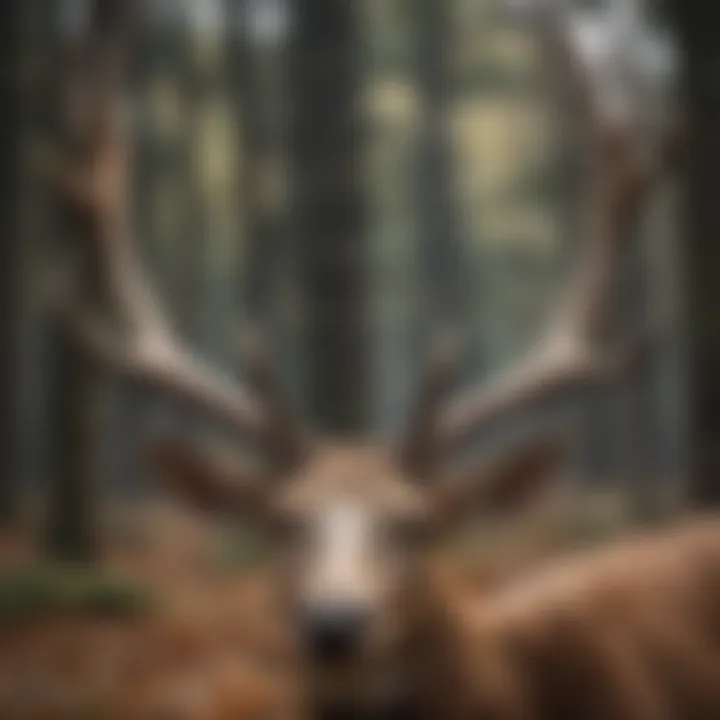
The rutting season for deer is not just a predetermined period; it's dynamic, influenced by several key factors that shape when and how this critical event unfolds. Understanding these factors can enrich our knowledge about deer behavior and population dynamics, which in turn impacts conservation strategies. By exploring environmental impacts and human interference, we can appreciate the intricate ballet of nature that dictates the rhythm of deer populations.
Environmental Impacts
The environment is perhaps the most significant player in determining the timing and intensity of the rut. Various climate aspects, from temperature to precipitation, play a role in how deer engage during this vital phase. Warmer temperatures can lead to earlier rutting seasons, while harsher conditions may push it later as deer adapt to survive.
- Temperature Variations: A sudden drop in temperature may trigger hormonal surges in male deer, pushing them to exhibit rutting behaviors ahead of their usual schedule. For example, during an abnormally warm autumn, deer might delay rutting altogether, confusing both potential mates and rival males.
- Food Availability: A bountiful food supply encourages healthy deer, which in turn enhances reproductive success rates. If the food sources dwindle due to drought or overgrazing, stress in deer populations can influence not only rut timing but also the overall vigor of the animals involved in mating.
- Habitat Quality: Quality of the habitat affects deer density and, subsequently, competition among males. In well-managed areas, males may rut more intensely than in regions where food is scarce or fragmentation of habitats has occurred.
"Understanding how environmental conditions affect the rut can help implement better wildlife management strategies."
Human Interference
Human activities invariably leave a footprint on the natural habitat of deer, influencing their rutting behavior in multifaceted ways. Whether through direct interaction—like hunting—or through indirect effects such as land development, these influences can shift the timing and intensity of the rut.
- Land Development: Urbanization and agricultural expansion can disrupt migration routes and limit access to food sources. This disruption can lead deer into dangerous situations around roads and human settlements during rutting when they might otherwise be focused on mating behaviors.
- Hunting Pressures: Regulated hunting can have a double-edged sword effect. In some areas, it can help manage deer populations, keeping them healthy and sustainable. However, excessive hunting during rutting can stress deer and force them into hiding, delaying mating opportunities.
- Wildlife Management Practices: Conservationists often implement measures to promote deer populations, such as controlled burns or habitat restoration. These practices can directly enhance environmental conditions conducive to a successful rut.
By examining the environmental impacts and human interference on the rutting season of deer, we gain insight into the bigger picture of wildlife conservation. Understanding these factors is crucial, not just for deer enthusiasts and hunters, but for anyone involved in or concerned with the management of wildlife and natural resources.
Rutting Season and Population Dynamics
In the intricate web of nature, the rutting season for deer is not merely a time of heightened activity; it's a crucial period that influences the overall dynamics of deer populations. An understanding of this phase can shed light on what happens in the wild and how it impacts both the species and its ecosystem. It’s during this season that the reproductive cycle reaches its zenith, thus having significant implications for population sustainability.
The rutting season directly affects reproductive success rates and the survival of fawns, among other critical dimensions of population dynamics. By delving into these aspects, we glean valuable insights into how deer populations adjust in numbers, genetics, and behavior throughout this vital time.
Reproductive Success Rates
When discussing reproductive success rates, we are looking at how many offspring are born during the rutting season that survive to maturity. The conditions during the mating period—ranging from environmental factors to social structures—play a pivotal role in determining these rates. For instance, when conditions are favorable, with ample food and low stress levels, you may see higher success rates. Deer that are in peak health are much more likely to reproduce effectively, leading to a population that thrives.
Moreover, male deer often engage in fierce competitions for the attention of females. This jockeying for dominance can lead to injuries or fatalities among the competing males. The consequences of these interactions can ripple throughout the population, influencing genetic diversity and overall herd health.
For example, a male that wins a number of fights and mates with several females has a greater probability of passing on robust genes to future generations. Conversely, if many males are injured or fail to mate, it can lead to lower reproductive success for that season. Thus, understanding these dynamics can provide insights not only into individual species but also into ecological health overall.
Survival Rates of Fawns
The survival of fawns is a crucial component of deer population dynamics, linking directly back to the conditions set by the rutting season. After mating, it is critical that does (female deer) find safe and suitable environments to give birth and raise their offspring. Survival rates can fluctuate significantly based on various factors:
- Predation: Increased predator activity can lead to higher fawn mortality rates, making it imperative for does to choose birthing sites wisely.
- Availability of Resources: If food sources are scarce, the health of both the doe and her fawns may suffer. A well-nourished mother is more likely to produce healthy offspring.
- Weather Conditions: Harsh weather can directly impact fawn survival. Cold or wet conditions can lead to increased mortality, especially in young and vulnerable deer.
Statistically, fawn survival rates can range dramatically, but studies indicate that about % of fawns may survive their first year in optimal conditions, while this number can drop to as low as % when facing adversities.
Understanding these elements allows conservationists, students, and environmentalists to proactively engage in more informed wildlife management practices, ensuring that deer populations can thrive sustainably amidst the challenges they face.
Observational Opportunities During the Rut
The rutting season for deer isn't just a fascinating time for wildlife; it serves as a golden opportunity for those wishing to observe these majestic creatures in their natural habitat. By understanding the intricacies of deer behavior during this critical period, wildlife enthusiasts, conservationists, and researchers can glean insights that might otherwise slip under the radar. Observing deer interactions during rutting season unveils a unique window into the lives of these animals, highlighting their reproductive strategies and social structures.
During rutting season, male deer exhibit striking behaviors, often engaging in vocalizations and displays of dominance. Recognizing these patterns can enhance the viewing experience tremendously. Not only does it allow for deeper learning about deer biology, but it also fosters a greater appreciation for ecological balance. And let’s face it—there's something remarkably humbling about watching nature unfold without any filters or preconceived notions.
Best Practices for Wildlife Observation
When gearing up to observe deer during the rut, a few best practices can help ensure a successful and respectful experience. Here are some key points to consider:
- Plan Ahead: Research the timing and location of the rut in your area. Knowing the peak periods enhances chances of witnessing crucial interactions.
- Use Binoculars or a Spotting Scope: Getting the right perspective can significantly improve your viewing experience. You don’t want to intrude on their space; binoculars can offer a front-row seat—without the front-row ticket price.
- Maintain a Safe Distance: Wild animals can behave unpredictably, especially males during rut. Observe from afar to prevent stressing the animals or interfering with their natural behavior.
- Stay Quiet and Patient: Patience is golden when it comes to wildlife observation. Rushing into an area or creating too much noise can scare them off. Instead, find a good spot, sit still, and allow the wildlife to come to you.
- Dress Appropriately: Wear camouflage or earth-toned clothing to blend into the environment. This helps you remain unobtrusive.
Practicing these ideals not only benefits the observer but also honors the natural world and its intrinsic rhythms.
Location Recommendations
Selecting the right location for deer observation during rutting season can make all the difference. Here are some prime spots worth considering:
- State Parks and Wildlife Reserves: Many of these areas provide ample opportunities to spot deer in their natural settings. Not only do they usually have rules in place to minimize human-wildlife conflict, but they often feature good vantage points and trails.
- National Forests: These vast untamed areas often serve as prime habitats for deer. Settle down near water sources or clearings where deer frequently visit for food and hydration.
- Private Land with Permission: If you know landowners passionate about wildlife conservation, ask for permission to observe on their land. It might provide incredible opportunities to see deer in areas less affected by human traffic.
- Local Trails and Open Fields: Urban and suburban settings often have pockets of land where deer are known to roam. Parks or even large backyards can be surprisingly good for observation during the rut.
Remember, whenever nature calls, listen closely and respect the privacy of its inhabitants. Through careful observation and courteous practices, you can contribute to a shared understanding of the complex lives of deer and their vital role within the ecosystem.
Rutting Season: Cultural and Economic Aspects
Understanding the cultural and economic aspects of the rutting season provides a lens through which to view the significance of deer in various societies and economies. This period is not merely a biological event; it weaves itself into the fabric of local traditions, hunting practices, and even broader conservation efforts. Recognizing its importance can lead to more informed wildlife management practices and enrich the dialogue about environmental stewardship.
Cultural Significance of Deer Rutting
The rutting season has deep roots in many cultures. In rural areas, it is often commemorated through festivals or rituals that celebrate the changing seasons and the cycles of life. In Native American cultures, for instance, the rut symbolizes a time of reflection on the balance of nature. Ceremonies during this period may honor the deer, which have been vital for sustenance and material culture.
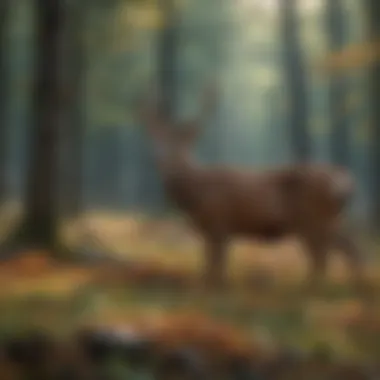
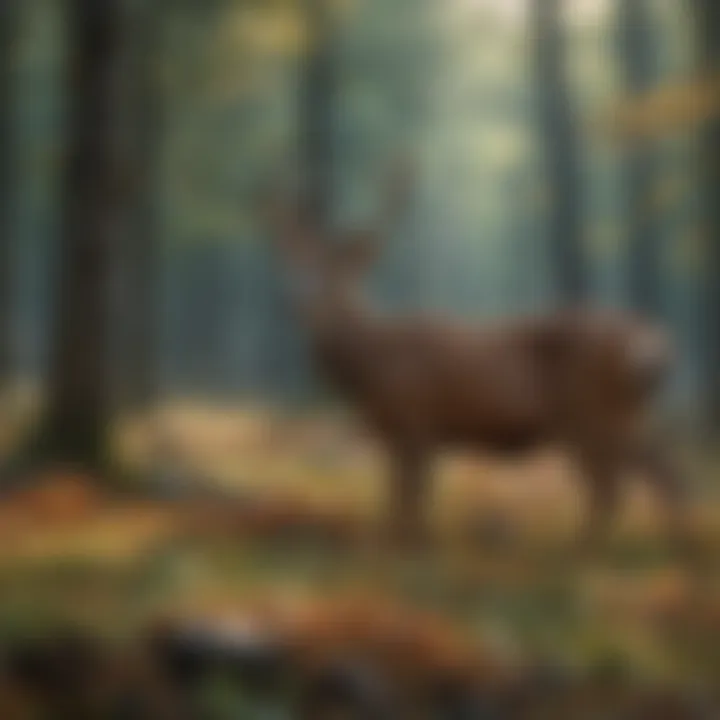
The visual and auditory spectacles of rutting male deer—fighting, calling, and chasing females—have inspired stories, art, and photography. This majestic display is often referenced in literature and folklore, serving to strengthen the bond between humans and nature. The presence of the rut can provoke a sense of awe and respect, reminding communities of their interconnectedness with the environment.
Impact on Local Economies
The rutting season influences local economies in several vital ways, primarily through recreational and hunting activities. Here are some critical points to consider:
- Hunting Seasons: The deer rut is closely tied to regulated hunting seasons, which provide economic benefits by attracting hunters from other regions. This influx leads to increased sales in local businesses—from sporting goods stores to hotels.
- Wildlife Tourism: Enthusiasts interested in wildlife observation often flock to areas known for their deer populations during the rut. This can spur investment in tourism infrastructure, benefiting communities economically.
- Conservation Funding: Understanding the dynamics of deer populations during the rut can inform conservation strategies, leading to funding opportunities for local wildlife management agencies. Engaging the community in these efforts fosters a sustainable economic model, particularly in rural areas.
"The rutting season is both a natural spectacle and an economic engine for many communities; understanding its multifaceted implications is crucial for balanced management."
Investing in educational programs about the rutting season can further enhance local awareness and participation in conservation initiatives. Overall, the cultural and economic implications of the rutting season are profound, influencing everything from individual livelihoods to the preservation of local traditions.
Implications for Conservation Efforts
The rutting season for deer is not just a fascinating spectacle; it carries weighty implications for conservation efforts. This period, marked by unique behaviors and ecological interactions, offers insights that can enhance our understanding of wildlife dynamics. Conservationists and environmentalists can leverage these insights to develop targeted strategies that sustain deer populations while preserving their habitats.
Understanding Ecological Balance
At the heart of effective conservation lies the understanding of ecological balance. When deer engage in their rutting season, they influence more than just their species; they impact the entire ecosystem. The mating behaviors, territorial disputes, and resulting population changes can shift the balance within an ecosystem. Consider the following points:
- Regeneration of Vegetation: Healthy deer populations help with the natural pruning of shrubs and trees. However, overcrowding leads to over-browsing, which can stunt plant growth.
- Predator-Prey Relationships: When deer populations increase or decrease due to rutting behaviors, it affects predator species, such as wolves and coyotes, which rely on deer for food.
- Soil Health: The movement of deer during rutting can lead to soil churn, which might enhance soil nutrient distribution but could also lead to erosion if not managed properly.
These points emphasize that deer are integral to their ecosystems. Their behaviors during rutting must be monitored to prevent negative impacts on flora and fauna, which underscores the importance of adaptive management practices.
"In studying the rutting season, we glimpse the intricate web of interactions within ecosystems—highlighting the need for informed conservation strategies that maintain this balance."
Management Strategies for Sustainable Populations
Having established the role of deer in ecological balance, it’s essential to adopt management strategies that ensure their populations remain sustainable. Effective approaches require a blend of research, community involvement, and policy-making. Here are some considerations:
- Monitoring Populations: Wildlife biologists must track deer populations throughout the rutting season. Implementing technology, like drones or camera traps, can aid in gathering data effectively.
- Habitat Management: Creating and maintaining diverse habitats ensures deer have the resources they need, especially in times of stress post-rutting when energy levels wane.
- Engaging Local Communities: Promoting awareness about the deer’s role in the ecosystem can foster community support for conservation efforts. Educational programs can be instrumental.
- Policy Frameworks: Developing legislation that focuses on sustainable hunting practices can mitigate population declines, thus enhancing genetic diversity and overall health of deer populations.
Emphasizing these strategies within the context of the rutting season allows for proactive management that helps maintain healthy deer populations while safeguarding biodiversity. By understanding the seasonal implications on behavior and population dynamics, conservationists can not only react but also anticipate challenges that arise in managing these key species.
Future Research Directions
The realm of deer behavior during the rutting season is laden with layers yet to be uncovered. Understanding these nuances is not just an academic venture; it holds significant implications for conservation strategies, population management, and habitat preservation. The complexity of mating rituals and behavioral adaptations offers fertile ground for ongoing studies, which could inform practices aiming to sustain and enhance deer populations within their ecosystems.
Emerging Studies on Deer Behavior
Recent studies in wildlife biology have started to shed light on the intricate patterns of deer behavior during the rut. Researchers are now focusing on how external factors, such as changes in temperature and food availability, interact with deer’s natural instincts.
For instance, one area of interest involves how urbanization influences male aggression during the rut. Deer often navigate through parks and residential areas to follow traditional rut paths. This behavior could lead to increased confrontations with vehicles, resulting in a pressing need for wildlife crossing projects and urban planning that accommodates these seasonal movements.
Moreover, scientists are investigating the communication methods among deer during mating. Vocalizations and body language play critical roles, and understanding these could enhance strategies for wildlife observation and management. Through the examination of deer response to varying stimuli, researchers can create models that predict population dynamics, especially as climates become more unpredictable.
"Understanding deer behavior is a puzzle that connects ecological balance with human activity. By observing how deer react to their environments, we stand to improve their management, ensuring future generations can witness their incredible rutting rituals."
Technological Advances in Wildlife Research
The advent of technology in wildlife research is revolutionizing how we study deer during the rut. Innovations such as GPS collaring and motion-sensitive cameras have provided valuable insights into movement patterns and behaviors. For example, GPS collars allow researchers to track deer migration through seasons, analyzing how environmental shifts impact their routines and reproductive success.
Additionally, drones equipped with thermal imaging are becoming common tools for tracking deer in vast areas without intrusive methods. These high-tech gadgets can detect body heat, helping conservationists assess deer populations without the stress that often accompanies traditional tracking methods.
Incorporating machine learning into data analysis has also proven beneficial, allowing researchers to predict behaviors and potential outcomes based on previous data. This sophistication opens avenues not just for understanding rutting patterns, but for creating more effective habitat management strategies.
The combination of behavioral studies and technological advancements presents a powerful opportunity for wildlife professionals. By embracing these methodologies, future researchers can contribute to sustainable deer management practices, drawing a clearer connection between scientific findings and practical applications in conservation.
Finale
The conclusion serves as a pivotal piece in our exploration of the rutting season for deer. It ties together the myriad threads we’ve unraveled throughout the article. Understanding the dynamics of rutting season sheds light on various dimensions of deer behavior and ecological impact, ultimately informing effective management strategies.
Summarizing Key Findings
This article has highlighted several key aspects of the rutting season:
- Timing: The rutting season occurs at different times across regions and is influenced by various environmental factors.
- Behavioral Shifts: Having explored male and female behaviors during this season, we see a clear shift in male aggression due to competition, while females display heightened selectivity in mate choice.
- Biological Mechanisms: Hormonal fluctuations play crucial roles in driving the behavior changes associated with this period, with genetics further framing how individuals cope and thrive in their specific habitats.
- Conservation Implications: The interrelationship between rutting and population dynamics emphasizes the necessity of conservation efforts tailored to understand these natural rhythms.
- Observational Opportunities: Those interested in wildlife observation can significantly benefit from knowledge of this season, pinpointing the best practices and locations for observing such pivotal interactions.
In summary, a comprehensive understanding of the rutting season equips individuals, particularly conservationists and environmentalists, with the knowledge and tools to navigate the complexities of deer populations and their ecological roles.
Final Thoughts on Deer Rutting Dynamics
Deer rutting dynamics form an intricate dance of instinct, adaptation, and survival. It’s a period marked by fierce competition, yet it’s also a time when the survival and fertility of the species hinge on individual and group behaviors. Recognizing the subtleties of these dynamics can enhance approaches to wildlife management and conservation efforts.
As we look forward, it’s essential to continuously build on our knowledge regarding deer behavior during the rut. Engaging in future research, observing changes, and understanding the impacts of human activities will not only enrich our comprehension of deer populations but also ensure that we maintain ecological balance.
Maintaining the ecological balance of deer populations during rutting season could help safeguard their future and the environment they inhabit.
In closing, comprehending these intricate patterns during the rut can lead to better conservation practices, ultimately preserving the delicate ecosystems that both humans and deer depend on.



